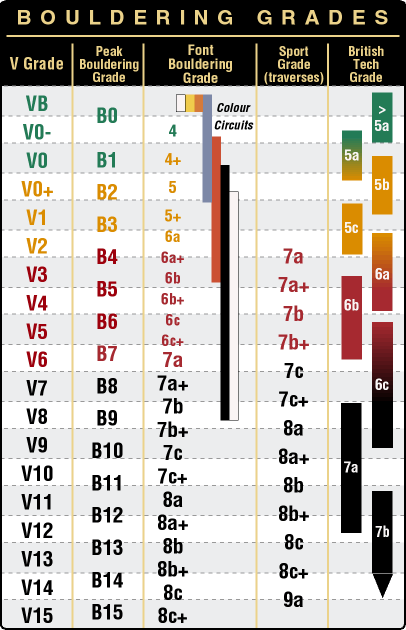Bouldering
Bouldering is the simplest and cheapest form of climbing - no harness, helmet or ropes required only a pair of climbing shoes, some chalk and a crash mat (referred to as a bouldering pad or just 'pad'). It involves climbing a very short distance (a 'boulder problem') but with a much greater degree of difficulty in comparison to climbing longer routes. Bouldering is the only style of climbing that can be done by a single person rather than a pair which adds to its appeal.
As boulder problems can exist on very small sized boulders, usually a sit-down-start is added to increase the difficulty of the problem without increasing the danger. Bouldering can exist on very large walls too, but only complete the first small section of the wall to a designated finishing hold (which usually needs to be 'matched' or have both hands touch it in a controlled manner).
Rules
Boulder problems have very strict rules, which should be adhered to to legitmately claim completion of a problem. These are:
- Eliminates - 'Climb the arete without using the crack' is an example of an eliminate. In this case the arete should be climbed but no part of the climber should touch the crack, be it crack climbing, laybacking or resting. Eliminates can also include specific holds and/or specific limbs ie 'Climb the arete using only feet in the crack'.
- Dabbing - A dab is where a boulderer touches an obstacle that has been eliminated from the problem (including the floor) thus providing a split second of potential aid during the climbing. Dabs are usually unhelpful and unintentional, however ethics dictate a legitimate ascent must be dab-free.
- Finishing holds - As previously mentioned must be matched unless otherwise stated.
- Permissible holds - Same as an eliminate, but where specific holds are to be omitted rather than features.
- Sit starts - Only where the problem specifies or appears it should be started sat down.
Physique
The nature of bouldering typically requires a larger muscle mass to produce a small number of powerful moves to complete the problem, rather than a large amount of endurance as common with sport and trad climbing. Core strength is also key and essential for severely overhanging and steep problems which are also common boulder problems.
Grades
There are predominantly two grading systems used to class boulder problems. These are the Font grade and the Hueco V grade. The Font grade follows a similar format to sport climbing grades (Font 4a, Font 4b, Font 4c, Font 5a etc.) however THEY ARE NOT THE SAME. The hueco V grading system was devised in the Hueco Tanks bouldering area in North America and simply uses numbers for the majority of classification.

Despite the common avoidance of powerful climbing, bouldering at easy grades still exists and can involve delicate work on slabs. RAC Boulders in North Wales is an example of a crag which has a range of VB's to V0's along a slabby face - brute strength wont help you here!
Equipment
As boulder problems are typically short the time spent attempting to climb a problem isn't that long. Wearing tight fitting shoes helps to turn down toes to fit on smaller holds but can only be worn for a short period of time due to the pain. Conveniently these two go hand in hand for bouldering and the sight of barefooted climbers resting is not uncommon. Climbing shoes with velcro straps are popular as they are quick and easy to put on and take off.
Chalk comes in two main forms. As chalking up is done before a problem (and the problem may not be long) a 'boulder bucket' is sometimes used filled with loose chalk powder. Essentially a very large chalk bag, the climber dips his/her hand into the bucket to chalk up their hands before climbing the route. Equally as common are chalk bags used for all other types of climbing with a ball of chalk inside.
Bouldering pads are large pieces of multiple density foam covered with a tough fabric to stop rips. They are designed to absorb impact forces when a climber falls off a problem onto their feet - it is not recommended to fall off onto any other body part onto a pad, as the absorbtion rate is not sufficient enough to prevent injury. From high problems falling onto a pad feet first is usually followed by the rest of the body collapsing onto the pad, but this is fine as by this point the legs have absorbed most of the kintetic energy. Boulder pads vary in price, mostly attributed to their surface area and thickness. Dedicated boulderers usually have more than 2 pads of different sizes and thicknesses.
Technique and Sequences
Although powerful, technique in bouldering is equally as important. As the problems are short, the boulderer can be expected to perform multiple techniques back-to-back wihtout rests inbetween. This series of movements is called a sequence and when practising (working) hard problems a sequence will become engrained in a boulderers mind as he/she rehearses the problem repeatedly. Sequences are entirely personal and what works for one person wont always work for another.
